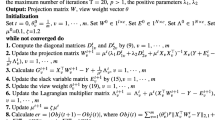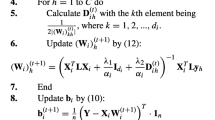Abstract
Multi-view data can depict samples from various views and learners can benefit from such complementary information, so it has attracted extensive studies in recent years. However, it always locates in high-dimensional space and brings noisy or redundant views and features into the learning process, which can decrease the performance of the learner. To address the above issue, we propose a novel unsupervised Multi-view Dimensionality Reduction learning framework with Hierarchical Sparse Feature Selection (MvDRHSFS) to learn a low-dimensional subspace by jointly selecting the most informative views and features hierarchically. More specifically, we penalize the projection matrix with Frobenius norm (F-norm) and l2,1-norm to select the most informative views and features hierarchically. Under the penalty of the two regularization terms, some projection-based Sigle-view Dimensionality Reduction (SvDR) methods can learn a more meaningful low-dimensional subspace of multi-view data. In practical implementation, we use the regression type of PCA and relax the orthogonal constraint of the projection matrix to learn the low-dimensional subspace in a more flexible way. To find the optimal solution of the proposed learning framework, we derive an effective way to optimize the given formulation and give the theoretical analysis about the convergence for the optimization algorithm. Extensive experiment results on several real-world datasets demonstrate the feasibility and superiority of our proposed learning framework.







Similar content being viewed by others
References
Cai D, Zhang C, He X (2010) Unsupervised feature selection for multi-cluster data categories and subject descriptors. In: Proc. Spec. Interes. Gr. Knowl. Discov. data, Washington, DC, USA, pp 333–342
Fei-Fei L, Fergus R, Perona P (2004) Learning generative visual models from few training examples: An incremental bayesian approach tested on 101 object categories. IEEE Comput. Soc. Conf. Comput. Vis. Pattern Recognit. Work., 2004-Janua. https://doi.org/10.1109/CVPR.2004.383
Feng L, Meng X, Wang H (2020) Multi-view locality low-rank embedding for dimension reduction. Knowledge-Based Syst 191:105172. https://doi.org/10.1016/j.knosys.2019.105172. arXiv:1905.08138
Gao Y, Lin T, Zhang Y, Luo S, Nie F (2021) Robust principal component analysis based on discriminant information. IEEE Trans. Knowl. Data Eng., (pp 1–14). https://doi.org/10.1109/TKDE.2021.3093447
Guo W, Wang Z, Du W (2022) Pseudolabel-guided multiview consensus graph learning for semisupervised classification. Int. J. Intell. Syst., (pp 1–24). https://doi.org/10.1002/int.22958
Guo W, Wang Z, Hong S, Li D, Yang H, Du W (2021) Multi-kernel support vector data description with boundary information. Eng Appl Artif Intell 102:104254. https://doi.org/10.1016/j.engappai.2021.104254
Guo W, Wang Z, Ma M, Chen L, Yang H, Li D, Du W (2022) Semi-supervised multiple empirical kernel learning with pseudo empirical loss and similarity regularization. Int J Intell Syst 37:1674–1696. https://doi.org/10.1002/int.22690
He X, Yan S, Zhang H.-J. (2005) Neighborhood preserving embedding. In: Proc. IEEE Int. Conf. Comput. Vision, Beijing, China (pp 1208–1213)
Hu X, Sun Y, Gao J, Hu Y, Yin B (2018) Locality preserving projection based on f-norm. In: Proc. AAAI Conf. Artif. Intell. New Orleans, Louisiana, USA (pp 1330–1337)
Huang S, Tsang I, Xu Z, Lv JC (2021) Measuring diversity in graph learning: a unified framework for structured multi-view clustering. IEEE Trans Knowl Data Eng, 1–14. https://doi.org/10.1109/TKDE.2021.3068461
Ikizler N, Cinbis RG, Pehlivan S, Duygulu P (2008) Recognizing actions from still images. In: Proc. Int. Conf. Pattern Recognit., pp 1–4. https://doi.org/10.1109/icpr.2008.4761663
Kumar A, Rai P, Daumé H (2011) Co-regularized multi-view spectral clustering. In: Proc. Adv. Neural Inf., Proc.ss. Syst. Granada, Spain, pp 1413–1421
Li Y, Nie F, Huang H, Huang J (2015) Large-scale multi-view spectral clustering via bipartite graph. In: AAAI Conf, Artif. Intell., pp 2750–2756
Li Y, Yang M, Zhang Z (2019) A survey of multi-view representation learning. IEEE Trans Knowl Data Eng 31:1863–1883. https://doi.org/10.1109/TKDE.2018.2872063. arXiv:1610.01206
Li Z, Liu F, Yang W, Peng S, Zhou J (2021) A survey of convolutional neural networks: analysis, applications, and prospects. IEEE Trans Neural Networks Learn Syst, 11–21. https://doi.org/10.1109/tnnls.2021.3084827. arXiv:2004.02806
Lian H, Zhang F, Lu W (2020) Randomized sketches for kernel CCA. Neural Netw 127:29–37. https://doi.org/10.1016/j.neunet.2020.04.006
Liu BY, Huang L, Wang CD, Lai JH, Yu PS (2021) Multiview clustering via proximity learning in latent representation space. IEEE Trans Neural Networks Learn Syst, 1–14. https://doi.org/10.1109/TNNLS.2021.3104846
Liu W, Yang X, Tao D, Cheng J, Tang Y (2018) Multiview dimension reduction via Hessian multiset canonical correlations. Inf Fusion 41:119–128. https://doi.org/10.1016/j.inffus.2017.09.001
Lu C, Lin Z, Yan S (2015) Smoothed low rank and sparse matrix recovery by iteratively reweighted least squares minimization. IEEE Trans Image Process 24:646–654. https://doi.org/10.1109/TIP.2014.2380155. arXiv:1401.7413v2
Ng AY, Jordan MI, Weiss Y (2001) On spectral clustering: Analysis and an algorithm. In: Proc. Adv. Neural Inf. Proc.ss. Syst. Vancouver, BC, Canada, pp 849–856
Nie F, Li J, Li X (2016) Parameter-free auto-weighted multiple graph learning: A framework for multiview clustering and semi-supervised classification. In: IJCAI Int. Jt. Conf. Artif. Intell. (pp 1881–1887). volume 2016-Janua
Nie F, Member S, Wang S, Wang Z, Wang R, Li X (2022) Discrete robust principal component analysis via binary weights self-learning. IEEE Trans Neural Networks Learn Syst, 1–14
Nie F, Wang Z, Wang R, Li X (2021) Adaptive local embedding learning for semi-supervised dimensionality reduction. IEEE Trans Knowl Data Eng, pp 1–13. https://doi.org/10.1109/TKDE.2021.3049371
Qiao L, Chen S, Tan X (2010) Sparsity preserving projections with applications to face recognition. Pattern Recognit 43:331–341. https://doi.org/10.1016/j.patcog.2009.05.005
Razzak I, Saris RA, Blumenstein M, Xu G (2020) Integrating joint feature selection into subspace learning: A formulation of 2DPCA for outliers robust feature selection. Neural Netw 121:441–451. https://doi.org/10.1016/j.neunet.2019.08.030
Seghouane AK, Shokouhi N, Koch I (2019) Sparse principal component analysis with preserved sparsity pattern. IEEE Trans Image Process 28:3274–3285. https://doi.org/10.1109/TIP.2019.2895464
Turk MA, Pentland AP (1991) Face recognition using eigenfaces. In: Proceedings 1991 IEEE Comput. Soc. Conf. Comput. Vis. pattern Recognit. (pp 586–587). IEEE Computer Society
Wang H, Peng J, Fu X (2019a) Co-regularized multi-view sparse reconstruction embedding for dimension reduction. Neurocomputing 347:191–199. https://doi.org/10.1016/j.neucom.2019.03.080. arXiv:1904.08499
Wang H, Yang Y, Liu B (2020a) GMC : Graph-based multi-view clustering. IEEE Trans Knowl Data Eng 32:1116–1129. https://doi.org/10.1109/TKDE.2019.2903810
Wang J, Xie F, Nie F, Li X (2021) Unsupervised adaptive embedding for dimensionality reduction. IEEE Trans Neural Networks Learn Syst, 1–12. https://doi.org/10.1109/TNNLS.2021.3083695
Wang Q, Gao Q, Gao X, Nie F (2017) Optimal mean two-dimensional principal component analysis with F-norm minimization. Pattern Recognit 68:286–294. https://doi.org/10.1016/j.patcog.2017.03.026
Wang W, Zhao Z, Wang P, Su F, Meng H (2022) Attentive feature augmentation for long-tailed visual recognition. IEEE Trans Circuits Syst Video Technol 8215:1–15. https://doi.org/10.1109/TCSVT.2022.3161427
Wang X, Lei Z, Guo X, Zhang C, Shi H, Li SZ (2019b) Multi-view subspace clustering with intactness-aware similarity. Pattern Recognit 88:50–63. https://doi.org/10.1016/j.patcog.2018.09.009
Wang Z, Zhu Z, Li D (2020b) Collaborative and geometric multi-kernel learning for multi-class classification. Pattern Recognit 99:107050. https://doi.org/10.1016/j.patcog.2019.107050
Xia R, Pan Y, Du L, Yin J (2014) Robust multi-view spectral clustering via low-rank and sparse decomposition. In: Proc. AAAI Conf. Artif. Intell. québec, Canada, pp 2149–2155, vol 3
Xia T, Tao D, Mei T, Zhang Y (2010) Multiview spectral embedding. IEEE Trans Syst Man Cybern Part B Cybern 40:1438–1446. https://doi.org/10.1109/TSMCB.2009.2039566
Xiaofei H, Niyogi P (2004) Locality preserving projections. In: Proc. Adv. Neural Inf, Proc.ss. Syst. Vancouver, Br. Columbia, Canada, pp 153–160 vol 16
Xie L, Tao D, Wei H (2016) Multi-view exclusive unsupervised dimension reduction for video-based facial expression recognition. In: Proc. Int. Jt. Conf. Artif. Intell. New York, USA, 2016-Janua, pp 2217–2223
Xu C, Tao D, Xu C (2013) A survey on multi-view learning. (pp 1–59). arXiv:1304.5634
Xu X, Yang Y, Deng C, Nie F (2019) Adaptive graph weighting for multi-view dimensionality reduction. Signal Process 165:186–196. https://doi.org/10.1016/j.sigpro.2019.06.026
Yi S, Lai Z, He Z, Ming Cheung Y, Liu Y (2017) Joint sparse principal component analysis. Pattern Recognit 61:524–536. https://doi.org/10.1016/j.patcog.2016.08.025
Zhang B, Qiang Q, Wang F, Nie F (2021) Flexible multi-view unsupervised graph embedding. IEEE Trans Image Process 7149:1–14. https://doi.org/10.1109/TIP.2021.3062692
Zhang C, Fu H, Hu Q, Member S, Zhu P (2017) Flexible multi-view dimensionality co-reduction. IEEE Trans Image Process 26:648–659
Zhang C, Hu Q, Fu H, Zhu P, Cao X (2017) Latent multi-view subspace clustering. In: IEEE Conf. Comput. Vis. Pattern Recognit, pp 4279–4287
Zhang Y, Wu J, Cai Z, Yu PS (2020) Multi-view multi-label learning with sparse feature selection for image annotation. IEEE Trans Multimed 22:1–14. https://doi.org/10.1109/tmm.2020.2966887
Zhao J, Xie X, Xu X, Sun S (2017) Multi-view learning overview: Recent progress and new challenges. Inf Fusion 38:43–54. https://doi.org/10.1016/j.inffus.2017.02.007
Zhou T, Zhang C, Gong C, Bhaskar H, Yang J (2020) Multiview latent space learning with feature redundancy minimization. IEEE Trans Cybern 50:1655–1668. https://doi.org/10.1109/TCYB.2018.2883673
Zhu X, Huang Z, Cui J, Shen HT (2013) Video-to-shot tag propagation by graph sparse group lasso. IEEE Trans Multimed 15:633–646. https://doi.org/10.1109/TMM.2012.2233723
Zhu X, Li X, Zhang S (2016) Block-row sparse multiview multilabel learning for image classification. IEEE Trans Cybern 46:450–461. https://doi.org/10.1109/TCYB.2015.2403356
Zhu X, Li X, Zhang S, Ju C, Wu X (2017) Robust joint graph sparse coding for unsupervised spectral feature selection. IEEE Trans Neural Networks Learn Syst 28:1263–1275. https://doi.org/10.1109/TNNLS.2016.2521602
Zou H, Hastie T, Tibshirani R (2006) Sparse principal component analysis. J Comput Graph Stat 15:265–286. https://doi.org/10.1198/106186006X113430
Acknowledgements
This work is supported by Natural Science Foundation of China under Grant No. 62076094, Shanghai Science and Technology Program “Distributed and generative few-shot algorithm and theory research” under Grant No. 20511100600, Shanghai Science and Technology Program “Federated based cross-domain and cross-task incremental learning” under Grant No. 21511100800, Chinese Defense Program of Science and Technology under Grant No. 2021-JCJQ-JJ-0041, China Aerospace Science and Technology Corporation Industry-University-Research Cooperation Foundation of the Eighth Research Institute under Grant No. SAST2021-007, and National Science Foundation of China for Distinguished Young Scholars under Grant No. 61725301.
Author information
Authors and Affiliations
Corresponding author
Ethics declarations
Conflict of Interests
The authors have declared no conflict of interest.
Additional information
Publisher’s note
Springer Nature remains neutral with regard to jurisdictional claims in published maps and institutional affiliations.
Rights and permissions
Springer Nature or its licensor holds exclusive rights to this article under a publishing agreement with the author(s) or other rightsholder(s); author self-archiving of the accepted manuscript version of this article is solely governed by the terms of such publishing agreement and applicable law.
About this article
Cite this article
Guo, W., Wang, Z., Yang, H. et al. Multi-view dimensionality reduction learning with hierarchical sparse feature selection. Appl Intell 53, 12774–12791 (2023). https://doi.org/10.1007/s10489-022-04161-4
Accepted:
Published:
Issue Date:
DOI: https://doi.org/10.1007/s10489-022-04161-4




